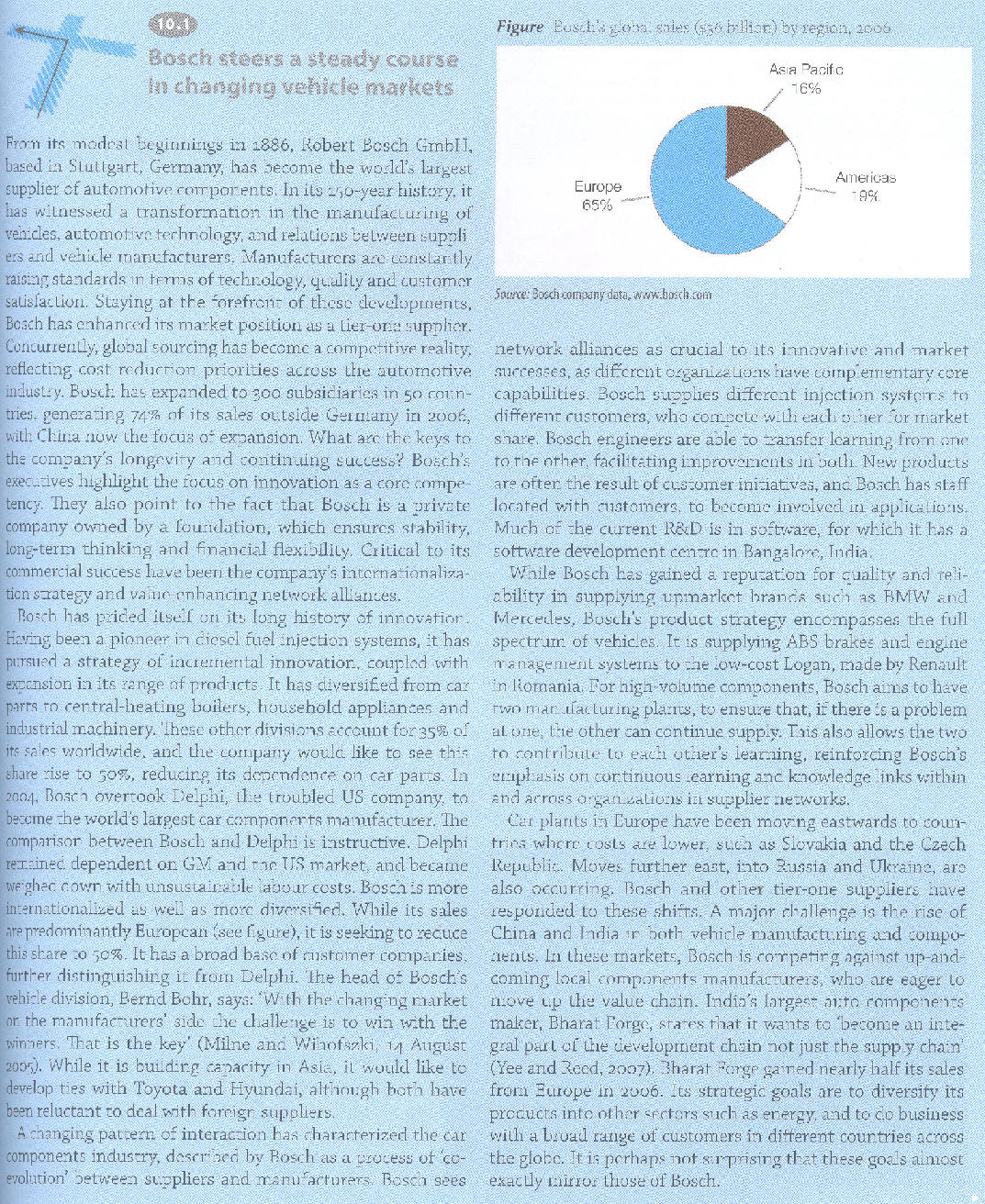Beyond the fragmented supply chain
(page 361)
In
what ways have new cooperative frameworks aided supply-chain
strategies in serving customers more quickly and with greater
responsiveness to changing demand, despite growing
inter-nationalization? Give examples.
|
It is helpful to begin by identifying the
characteristics of the fragmented supply chain: different
organizations operating on a contract-by-contract basis, with little
overarching co-ordination (see figure below).
The external supply chain
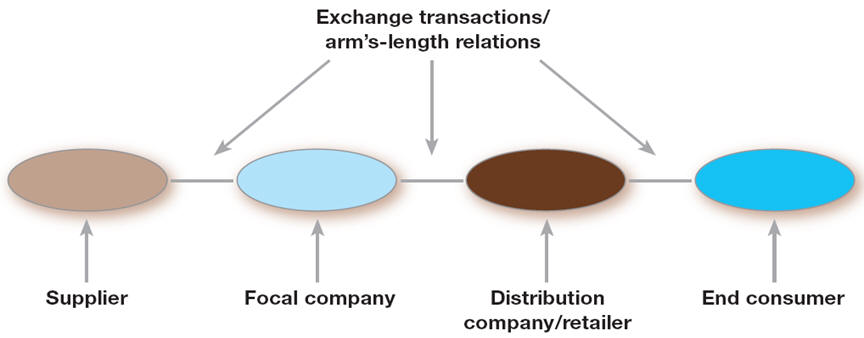
Vertical integration overcomes this fragmented
process, in that the organization exerts control over every phase.
However, internalization involves huge investment and costs. The
Ford Motor Company is often cited as an example. The newer network
approach is more streamline than the fragmented supply chain, and
benefits from flexibility which the vertically integrated operation
cannot match. The network consists of different organizations, but
they are working co-operatively, sharing information and maintaining
close ties. When circumstances of customer requirements change, the
organization can respond with a new network configuration. The
internet permits networks to be coordinated globally.
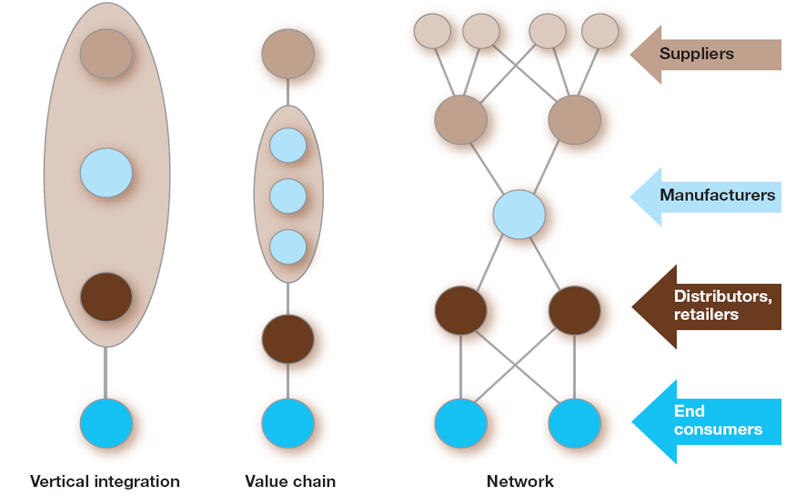
|
Make or buy decisions
in context (page 366)
Look again at the
sourcing options presented in Figure 10.3, reproduced alongside.
Which companies, in terms of national and corporate culture, are
likely to choose which option(s), and why? The companies may be
either types of firms or real ones.
|
To "make" or "buy" are not the simple
alternatives they might seem. Some firms see purchasing from an external
source as the sole alternative to making a product "in-house". However,
close relations between the suppliers and the customers, through
inter-firm alliances and networks, produce more integrated supply chains
and the blurring of organizational boundaries.
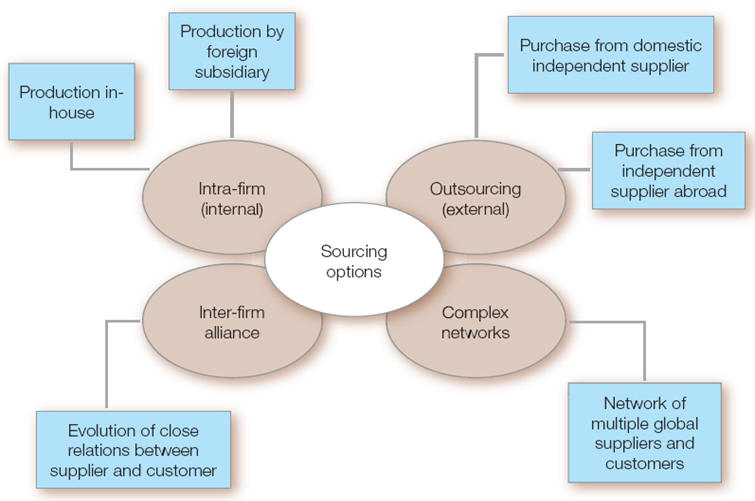
This figure covers 4 broad approaches to
'make-or-buy' decisions:
Intra-firm (internal)
– This approach is
that of the vertically integrated firm. Ford has a history of this
approach, although no longer pursues this strategy. US firms in this
group are likely to be ethnocentric. Unilever, which is more
polycentric, is historically in this category (see CS 7.1)
Outsourcing (external)
– This represents
the opposite approach to the first one, in that the firm contracts
at arm’s length with suppliers. Many firms which have a culture of
self-sufficiency and internalization see this as the logical
alternative – moving from one extreme to the other. Many American
companies have gone over to this approach. An example cited is
Boeing.
Inter-firm alliance
– This is one of the two
approaches which rely on relational ties, rather than purely
transaction-based ties. Japanese companies are noted for this
approach, but, as has been pointed out, inter-firm alliances have
tended to lead to complacency and inefficiency, leading executives
to seek more advantageous deals from external suppliers (see CS 7.2
on Nissan).
Complex networks
– This is a more recent
development. It involves flexible links, by which suppliers and
customers can share knowledge, benefiting both. As each is
constantly reacting to changing markets, participants are less
likely to become complacent, for fear that competitors are waiting
to take their place. Car manufacturing is an example, and Bosch is a
firm which can be cited as exemplifying this approach.
|
Sourcing in the era of
globalization (page 370)
In what ways do
sourcing decisions of MNEs exemplify the process of globalization,
and what aspects of sourcing indicate the importance of
localization?
|
Ways in which globalization
impacts on sourcing decisions:
-
Firms now look at a range of
suppliers globally before deciding on which one
to choose. This is
indicative of global supply chains, with different stages taking
place in different countries.
-
Internet and communications
technology make it possible to do business quickly and cheaply with
supplier firms across the globe, and to keep in touch.
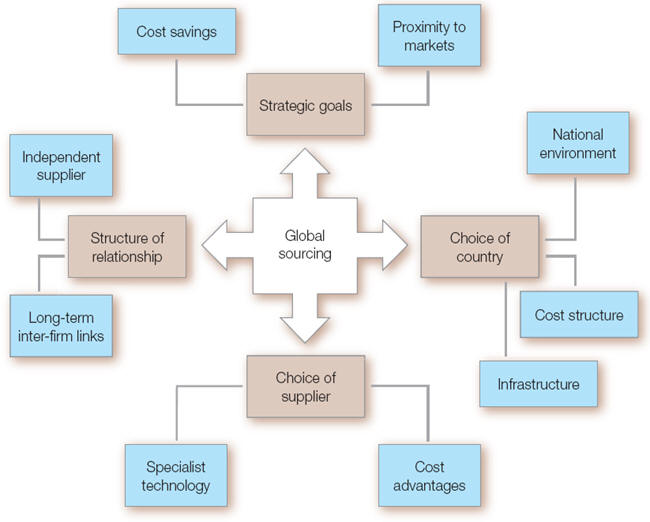
Ways in which localization
plays a role:
-
Individual countries enjoy location
advantages, such as abundant raw materials or low-cost labour, which
have benefited from the global scanning of MNEs.
-
FDI has benefited individual countries, but
each location presents a distinctive national environment, to which
the investor must adapt. The example of Toyota in India is cited.
|
Consumer-driven
manufacturing strategies (page 374)
Outline the ways in
which the following innovations in production are driven by the goal
of consumer satisfaction:
-
lean
production,
-
mass
customization,
-
modular
strategies, and
-
agile
manufacturing.
|
Mass production was once epitomized by the moving
assembly lines at Ford's gigantic River Rouge factory. Called Fordist
mass production, a top-down management system that was very inflexible
in that all the roles and responsibilities were formally allocated and
strictly followed, got eventually replaced by the flexible mass
manufacturing system. The design of the manufacturing process here
includes
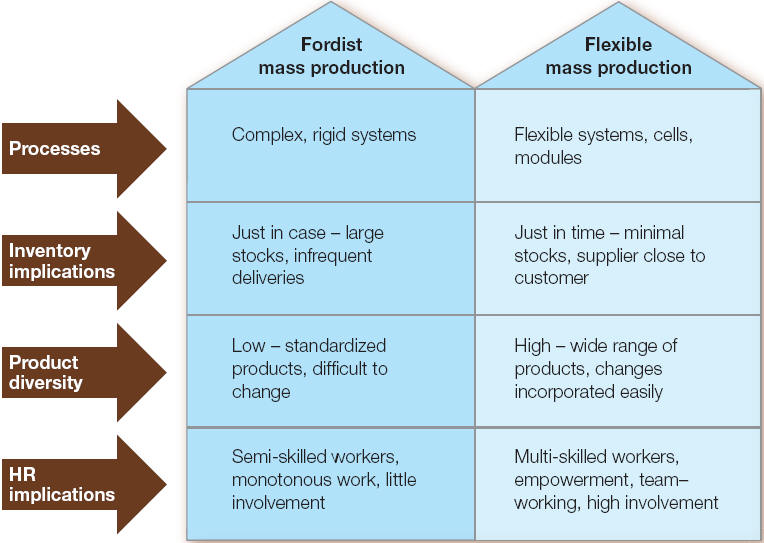
Innovations here have been driven by the need to
satisfy consumers in the following ways:
Lean production
– Lean production focuses
on reducing waste, including defects. This improves levels of
quality, and also reduces costs.
Modular strategy
– Modular strategy allows
production costs to be reduced, as a component can be used in
several different products. This means that products can be
customized, while keeping costs low.
Agile manufacturing
– This allows the
manufacturer to respond quickly to changing demand. It is associated
with lean production and JIT (Just-in-Time) systems. The benefits
for the consumer are that the company can respond easily to new
demand and the consumer is not faced with a long wait for the
desired product.
|
The manufacturing
supply chain
(page 375)
In what ways have changes in
manufacturing processes and changes in supplier relationships with
OEMs (Original Equipment Manufacturers) impacted on decisions about
where to manufacture?
|
Many manufacturing processes now envisage the
carrying out of different stages of a complex product in different
locations, to benefit from specific location advantages. |
|
Location
factors in manufacturing
Manufacturers
consider a number of factors in deciding where to manufacture
and which products to manufacture in which location. They
include costs of labor, including skilled labor, proximity to
suppliers, proximity to major markets, level of technology
involved, and the risks to their intellectual property in some
countries. |
|
|
The suppliers of specialist components often have considerable
expertise, and can therefore play a part in innovation and design of new
products from the manufacturer (see the example of Bosch). However, the
extended supply chain has drawbacks, in that it can be inflexible, and
there are risks in delivery and transport over long distances. If a
quality problem is spotted in the assembly of a final product, the
entire operation could be jeopardized as the firm awaits new components
(which could be coming from a company thousands of kilometers away).
Lean production systems rely on close collaboration between
organizations in the supply chain. Suppliers are often in the immediate
vicinity of customer.
As this chapter has shown, Japanese car
manufacturers rely on this type of relationship, but it can be difficult
to duplicate in other countries. Many manufacturers choose to make
high-value products in their home countries, and make low-value products
in foreign low-cost locations. Some companies have prioritized the
guarding of core competencies, and have been reluctant to outsource.
These companies tend to incur high costs if they are located in
developed economies, but many feel that their reputation for quality
justifies this approach. Germany, a high-cost economy, is still a strong
manufacturing country, valuing its high-quality engineering, although
many Germany companies now manufacture globally. This is an indication
of the need to formulate a global strategy on what activities to carry
out where, in seeking competitive advantage.
|
Quality in the
competitive environment
(page 382)
|
Quality management has evolved
from a functional approach to a broader management philosophy, which
involves the entire organization and supply chain.
Total quality management (TQM)
is the approach to quality that commits the entire organization to
continuous improvement principles and extends to supply chain patterns.
Six sigma is an approach to
quality management that analyses and seeks to improve performance using
a variety of quality measurement tools in order to eliminate defects and
reduce costs. |
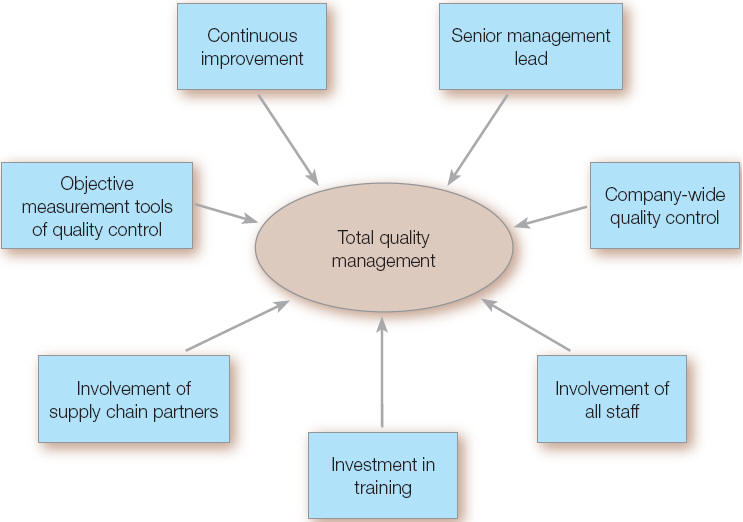 |
|
ISO 9000 standards too provide a means for
companies to apply and meet internationally recognized quality
standards.
Price competition has become fierce, and is a
major consideration in many product areas, as products become
standardized or ‘commoditized’. The basic mobile phone is an example.
Although consumers expect quality, they, like manufacturers, are aware
that quality is not an absolute concept. Expectations of quality and
durability vary according to the price of the product. However,
consumers do expect the product to perform as described, to be without
defects and to stand up to reasonable use. Quality systems such as Six
Sigma focus on cost reductions through the elimination of waste. This
approach accords with satisfying consumers that quality is not
sacrificed in mass-produced products.
The strongest growing markets at present are in
the large emerging economies such as China and India. In both countries,
cost is a primary criterion of consumers. China’s manufacturing strength
is well known, but India is now catching up in manufacturing. Quality
management systems are sometimes difficult to operate in developing
countries. An issue is the responsibility placed on individual workers,
which is entailed in continuous improvement systems. In countries of
large power distance, this type of approach is difficult to implement.
China manufactures more toys than any other country, mainly through
production under license for Western markets. Chinese toys have suffered
many setbacks due to poor quality, and brand owners have been criticized
by consumers, concerned about possible harm to children from poor
materials, poor design and defects.
|
Transport and
globalization (page 389)
In what respects
has transport been a facilitator of globalization? What are the
impacts, on both exporting and importing countries, of the huge
variations in transport infrastructure, and associated costs, in
today's world?
|
Transport as a facilitator of
globalization
The single biggest influence on
globalization in transport is probably the container ship (pictured on
the cover of this book) which reduced costs and improved safety.
Globalization is associated with the extended supply chain,
incorporating ports, rail and road. As the IT for managing these
movements improved, companies were able to link the different stages in
the supply chain together. The costs of transport dropped dramatically,
and as a result, shipping mass-produced products from ports in China to
Western markets became commonplace.
|
 |
|
Impacts
of the variations in transport infrastructure
Traditional ports must be adapted to take
container ships, and the new superships need extra wide berths, which
require further substantial investment. China has invested heavily in
huge container ports able to handle the new container ships which export
its goods. However, China is the exception. Port infrastructure varies
enormously around the world: the sums involved in funding are huge; the
timescale is long, and in many places, planning issues make it difficult
to bring such projects to completion. Importing countries therefore vary
widely in their ability to handle container ships. Poor road and rail
networks in many countries hamper the movement of goods, and also add to
costs. You might also consider the recent issue of piracy, mainly off
the coast of Somalia. In January 2009, the Chinese government sent its
own naval vessels to the area to protect shipping. Increased incidence
of piracy, along with rising insurance costs, could lead companies to
reconsider overland routes.
|
Rethinking
supply chains
(page 389)
Inflexible
vertically integrated supply chains gave way to more flexible, less
costly alternatives. Global sourcing also offers opportunities to
reduce costs. However, the changing environment and changing markets
are causing firms to rethink supply chain strategies. What specific
factors would you highlight as important in today's environment, and
what strategic responses would you recommend? Give examples from
different sectors.
|
The rethinking on supply chains can be prompted by
a number of factors. Indeed, companies should be constantly rethinking
supply chains. Some that might be mentioned with relevance to today’s
environment:
-
Changing security situation and political
instability in key countries in the supply chain. Also, particular
regions in a country may be more volatile than others. India is an
example, with considerable variation between regions. Companies
contemplating FDI in manufacturing in India must take these risks
into account.
-
The risk of insurgency and terrorist attacks
is more prevalent in some regions than in others. The extraction
industries in Africa are examples.
-
Financial and exchange risk are growing
factors in today’s volatile global financial environment.
-
Economic downturn can mean that supplier and
service companies face possible closure. A firm which depends on a
particular supplier could find that its future is in jeopardy.
Having an alternative supplier in mind is a possibility, but all
could be suffering from a generalized downturn. Many MNEs might
consider taking some key processes back in-house, which had been
outsourced in the past.
-
Transport can become problematic. Piracy
(mentioned above) can affect shipping, and has become a growing
problem of the coast of Somalia. Road and rail links are also
subject to change.
|
-
What challenges are posed by differing cultural environments
in quality management? Give examples.
As
manufacturing and supply chains spread to a wider range of developing and
transitional economies, differing levels of economic and technological
development become issues. These are linked to the cultural environment in
each case: a country in the early stages of industrialization, where most
people are still engaged in agriculture, differs from a more industrialized
economy, in that family ties and kinship values are likely to be stronger
than in industrial economies. In addition, every national culture has its
own historical roots, sense of identity and important symbols which bind
members together. It should also be noted that regions within countries have
distinctive cultures. India is an example: some areas of the country have
become more industrialized than others.
In individualist cultures, employees more readily accept
responsibility for quality systems than in collectivist cultures. In the
latter cultures, which often have large power distance, managers are seen as
the authority figures, and workers in subordinate roles. Workers are not
accustomed to thinking independently about ways to improve quality or
looking critically at processes to see how they can be improved. In many
developing and emerging economies, large power distance is the norm, and
paternalistic management prevails.
A second challenge faced by companies is that of weak
institutional environment, especially in developing countries. Much of the
impetus for quality improvement has come from government or industry-based
regulation in the developed economies. Where these frameworks are weak,
harmful and dangerous products are more likely to enter consumer markets.
Quality problems in China persuaded McDonald’s to take control of its entire
supply chain. The tainted milk scandal in China is another example. In this
case, a New Zealand company found its reputation damaged by association with
a Chinese firm found to be producing contaminated milk.
- Assess the challenges and risks currently
facing logistics management in international operations.
The threat of piracy on
the high seas is now a major worry for shippers and their customers.
Consumers have come to expect an array of imported goods, including food and
durable goods such as electronics, constantly available at reasonable
prices. A number of factors affect supply chains, which pose risk. This is
particularly true in a period of economic downturn.
Following are some of the challenges:










